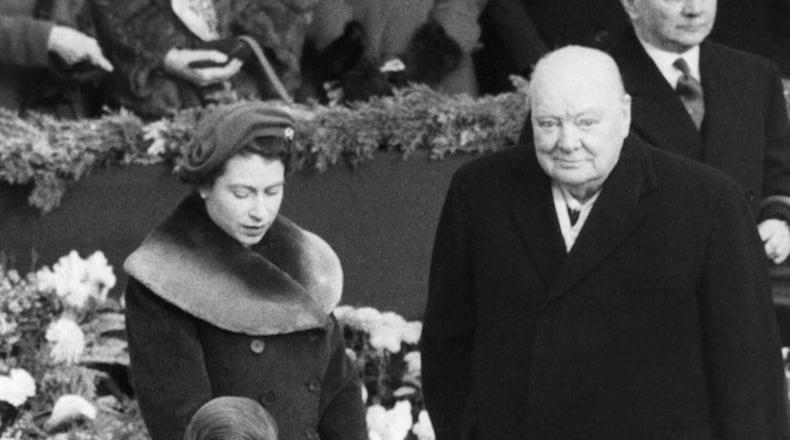HANOVER, Germany — It has been, perhaps, one of the most enduring mysteries of President Barack Obama’s tenure: What really happened to the bust of Winston Churchill that was once displayed in the Oval Office?
With just months left in his term, Obama’s first comments on the matter, in Europe last week, may have finally cleared up the truth of a tale that has persisted for more than seven years.
For conservatives in both America and Britain, the disappearance of the bust from its place of honor soon after the end of George W. Bush’s presidency was evidence of a liberal snub by Obama. In their view, he clearly did not fully appreciate the greatness of the British prime minister, who served during and after World War II. (The bust was replaced, White House officials said at the time, with one of Abraham Lincoln.)
The conservative columnist Charles Krauthammer, the onetime Republican presidential contender Mike Huckabee and Sen. Ted Cruz of Texas, a current Republican presidential candidate, are among those who have chastised Obama over the years for returning the bust to the British. Less than a month after Obama’s first inauguration in 2009, a British newspaper bluntly accused him of sending “Sir Winston Churchill packing.”
Not true, the White House insisted at the time, offering various explanations. William Allman, the White House curator, said in a 2010 interview with CBS News that the bust, on loan to Bush by Tony Blair, the former British prime minister, “was already scheduled to go back” before Obama took office.
The bust was returned “as a matter of course” by the new administration along with other art that had been on loan to Bush for display during his term in office, White House officials said. Dan Pfeiffer, the president’s communications director at the time, blasted Krauthammer, calling his charge about the disappearing bust “100 percent false” and saying that “news outlets have debunked this claim time and again.”
In a blog post labeled a “fact check” on the White House website, Pfeiffer wrote: “The bust still in the White House. In the Residence. Outside the Treaty Room.”
Pfeiffer later apologized to Krauthammer after admitting that the bust outside the Treaty Room was, in fact, a different Churchill bust, given to President Lyndon B. Johnson in the 1960s. Still, Pfeiffer insisted, the return of the Oval Office bust was “not something that President Obama or his administration chose to do” and was not “a symbol of President Obama’s failure to appreciate the special relationship.”
But late last week, Boris Johnson, the mayor of London, renewed the charge, writing in a British tabloid that the Oval Office bust had been “banished” and suggesting that it could be “a symbol of the part-Kenyan president’s ancestral dislike of the British Empire — of which Churchill had been such a fervent defender.”
Countering such charges is typically left to a president’s aides. But asked at a news conference Friday about the mayor’s comments, Obama seemed to relish the chance to set everyone straight, once and for all, about the fate of the Churchill bust.
The president started by explaining that when it came to Churchill, “I love the guy.” He offered as proof the Churchill bust that sits outside the Treaty Room, the president’s private office on the second floor of the White House residence, not far from the first family’s living quarters.
“I see it every day, including on weekends, when I’m going into that office to watch a basketball game,” he said. “The primary image I see is a bust of Winston Churchill. It’s there voluntarily, because I can do anything on the second floor. I love Winston Churchill.”
But then Obama went on to explain what had happened to the bust lent by Blair, the one that critics had accused him of summarily sending back to the British. It was, Obama said, his decision to return that Churchill to his native land, because he wanted to replace it with a bust of the Rev. Dr. Martin Luther King Jr.
“There are only so many tables where you can put busts. Otherwise, it starts looking a little cluttered,” the president explained. “And I thought it was appropriate, and I suspect most people here in the United Kingdom might agree, that as the first African-American president, it might be appropriate to have a bust of Dr. Martin Luther King in my office.”
He added that the choice of King was “to remind me of all the hard work of a lot of people who would somehow allow me to have the privilege of holding this office.”
That appears to contradict the longstanding denials by White House officials, including Pfeiffer, that neither Obama nor anyone else in his administration had chosen to dispatch Churchill’s likeness in favor of someone else’s. By Obama’s admission, he made the decision to replace the Churchill bust with one of King.
“I think people should know my thinking there,” Obama told the reporters in London.
Mystery solved.
Except for one thing: The version of events in which Lincoln had replaced Churchill was mentioned in most stories about the issue (including in this paper). Pfeiffer included news reports about it in his 2012 blog post attacking Krauthammer.
“The AP reported that President Obama ‘replaced the Oval Office fixture with a bust of one of his American heroes, President Abraham Lincoln,'” he wrote.
Mr. Pfeiffer no longer works for Mr. Obama; he is now vice president of communications and policy for GoFundMe, a website that helps its users raise money for causes.
Current White House officials said the Churchill bust had been replaced with one of King, but the Oval Office still has a Lincoln bust as well, perhaps leading to the confusion.
After all, one White House official noted, Obama did say the Oval Office could get a little cluttered.
About the Author
Keep Reading
The Latest
Featured



